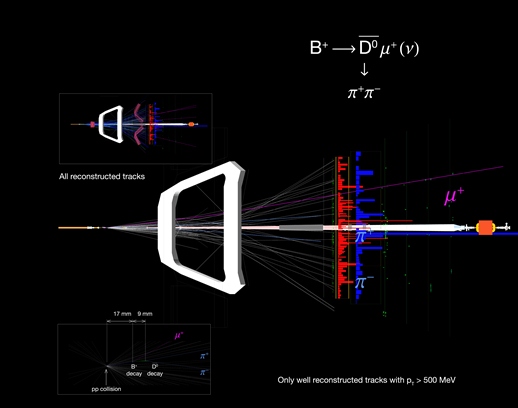[ ΔACP = (−0.34 ± 0.15 ± 0.10 )%, pion tagged ]
[ ΔACP = (+0.49 ± 0.30 ± 0.14)%, muon tagged ]
The LHCb Collaboration presented today at the Rencontres de Moriond QCD, La Thuile, Italy, results of an improved search for the difference between properties of matter and antimatter, CP violation, in charm decays, see 14 November 2011 news for introduction. The difference (Δ) of CP asymmetry (ACP) between the decay rates of D (matter) and D (antimatter) mesons into K+K– pairs and into π+π– pairs was measured. The results presented today profited from three improvements to the previous analysis: the full 1.0 fb-1 data sample collected in 2011 was used instead of 0.6 fb-1, the analysis technique was improved and also in addition another independent method was used to select matter D and antimatter D particle decays.
In the Standard Model CP violation was expected to be very small in the charm sector, whereas new physics effects could generate enhancements. Therefore the 14 November 2011 announcement by the LHCb Collaboration of 3.5σ evidence of CP violation in charm sector, ΔACP = (-0.82 ± 0.21 ± 0.11)%, triggered intensive theoretical activity with conclusions that some special Standard Model effects could generate CP violation effects even as big as about 1%. This interesting LHCb result was later confirmed by the CDF and Belle collaborations. The new improved LHCb result presented today, ΔACP = (−0.34 ± 0.15 ± 0.10 )%, is more precise thanks to the larger data sample and several improvements resulting in better background suppression by a factor of 2.5. The central value is, however, closer to zero than in the previous measurement, which it supersedes.
In the measurement presented above the D (matter) and D (antimatter) mesons were selected using the D* meson decays, D*+(-) → π+(-)D(D), which means that the presence of π+ in the decay identified matter D meson production while π– accompanied antimatter D production. LHCb physicists presented today also results of a second independent analysis in which the D and D mesons were selected using so called semileptonic beauty B decays, for example B+(-) → μ+(-)νD(D). In the second analysis, the positive charge of μ+ identified the D meson, while the negative one, μ–, the D production. The image at the left hand side shows a selected event. A zoom around the pp interaction point shows a B+ meson decay point located at the distance of 17 mm from the pp collision point and the D meson decay place still 9 mm further away. The second analysis also measures a value that is consistent with zero: ΔACP = (+0.49 ± 0.30 ± 0.14)%. A combination of the two LHCb results gives ΔACP = (-0.15 ± 0.16)%.
click the images for higher resolution
The image at the left hand side shows a comparison of different measurements of ΔACP. The previous LHCb result is shown as the shaded grey point. A naive world average is shown as the yellow band. As shown in the image, the two new LHCb results are consistent with each other and with other results at the 2σ level, but do not confirm the previous evidence of CP violation in the charm sector.
Theoretical work has shown that several well-motivated models could induce large CP violation effects in the charm sector. These new results constrain the parameter space of such models. Further update of this and related measurements will be needed to discover if – and at what level – nature distinguishes between charm and anticharm.
More details can be found in the LHCb presentation in La Thuile, in the LHCb paper and conference contribution. Read also the CERN Courier article. See update with the full Run 1 data sample in the 2014 paper and in the 2016 seminar, in the 2016 paper and CERN Courier article.


